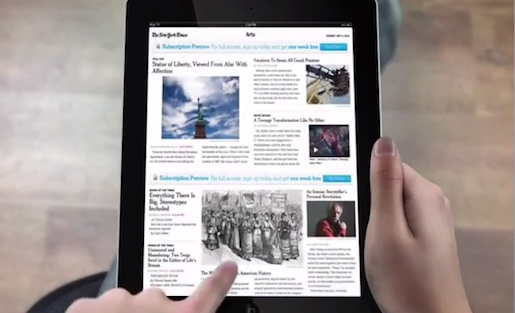Reported by Reuben Stern and Olga Kyle.
This week we see how Cinematique adds touch-screen interaction to video, how sensors are being employed to create new kinds of journalism and how some news organizations are shifting their thinking toward mobile audiences.
PART 1: Cinematique
A platform called Cinematique is making it possible for viewers of mobile video to get information about things they see by touching the screen as a video plays. We learn how it works from co-founders Kyle Heller and Randy Ross.
Reporting by Olga Kyle and Reuben Stern.
Our Futures Lab example:
Futures Lab video editor Olga Kyle took the Cinematique platform for a test drive with this behind-the-scenes clip. Tap or click throughout the video to learn more about where our show comes from:
PART 2: Sensor journalism
An emerging frontier in data journalism involves inexpensive sensors that can enable new kinds of storytelling by gathering information not tracked by anyone else. With a little help from the audience things can get even more interesting. We hear about the possibilities from John Keefe of WNYC and Matt Waite of the University of Nebraska-Lincoln.
Reporting by Ninh Pham and Reuben Stern.
Sensor journalism examples:
- WNYC’s cicada tracker enlisted the audience to help predict when a round of cicadas would emerge from the ground. Four key takeaways from the project are explained in detail in this piece from Nieman Journalism Lab.
- At the Online News Association conference in October, sensors were placed around a conference room, and the collected data projected live on a screen so attendees could see the variations in temperature and such around the room. Two technologists at Senselab, which built the network, provide technical details about the project in this post from the Tow Center for Digital Journalism.
- Another sensor project currently in the works involves using sensors to measure noise levels across a downtown area.
For more information:
WNYC’s data news team regularly posts updates and tips related to its work.
PART 3: Transitioning to mobile
As mobile devices increasingly become the technology of choice for consuming information, news organizations are once again having to adapt their focus to include another new medium with its own unique opportunities and constraints. We check in with a few newspaper organizations to see how they are making the transition.
Reporting by Tatiana Darie, Reuben Stern and Olga Kyle.
Reuben Stern is the deputy director of the Futures Lab at the Reynolds Journalism Institute and host and co-producer of the weekly Futures Lab video update.
The Reynolds Journalism Institute’s Futures Lab video update features a roundup of fresh ideas, techniques and developments to help spark innovation and change in newsrooms across all media platforms. Visit the RJI website for the full archive of Futures Lab videos, or download the iPad app to watch the show wherever you go. You can also sign up to receive email notification of each new episode.


